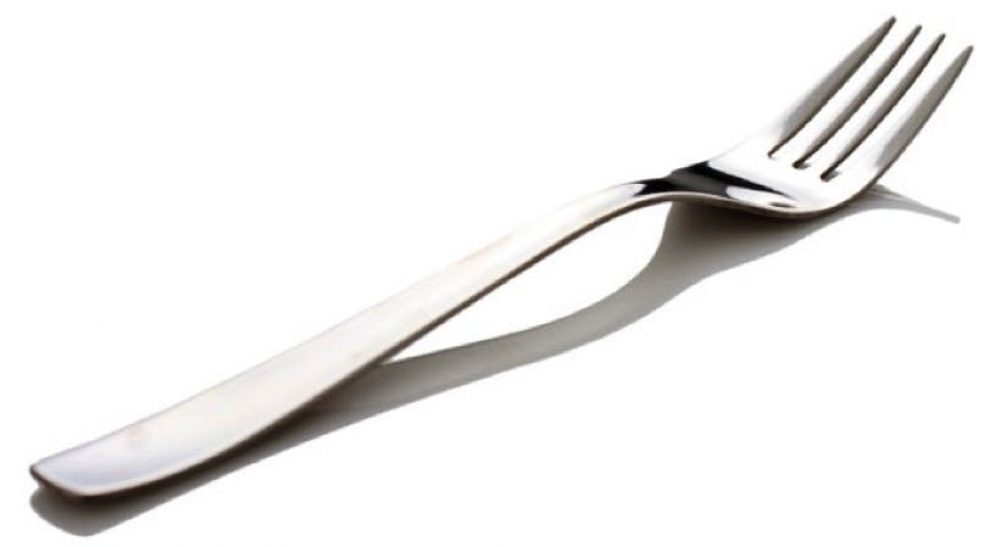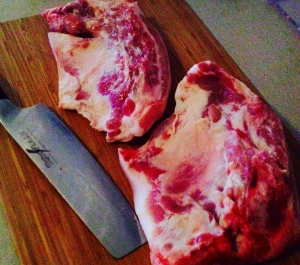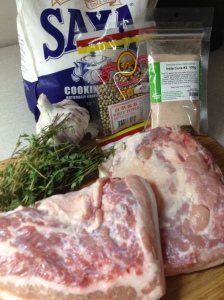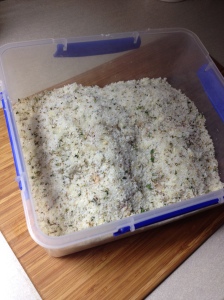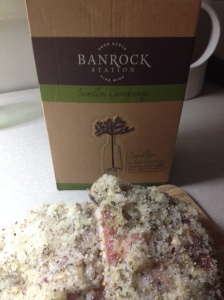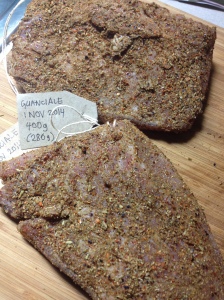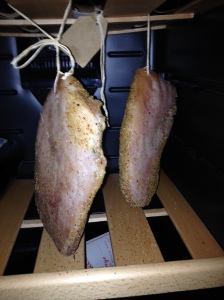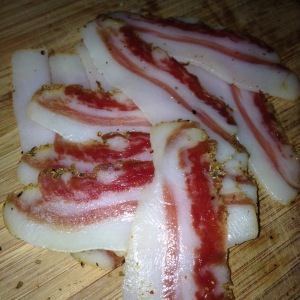Several weeks ago, I had a go at making my own bacon. This was my second foray into the world of simple homemade charcuterie, after duck prosciutto, which I recommend as a good entry-level effort to the craft of curing.
Bacon is pretty easy. Buy yourself some good quality, free-range pork loin or belly… or even better, the loin with the belly attached. Cure it in a mixture of salt, sugar, some cure #1, plus whatever other flavourings you want to add and then massage it into the meat. Chuck it all into a big zip-lock bag and put it in the fridge for a week, turning it every day or so. Once it’s cured, you can hot smoke it or in the absence of a smoker, cook it in a low (120C) oven for a couple of hours.
To make it smoky, you can lightly spray the meat with a liquid smoke before it’s popped into the oven. The one I bought from Misty Gully is great and smells like Cheetos’ Cheese & Bacon Balls. There are a few more steps to it than what I’ve outlined, but this post on the Overclockers Forum is a great resource if you want to give it a go yourself. Kudos to kodo78.
As for my attempt at bacon – it looked like and smelled like bacon. Finely cut and pan fried, it also tasted pretty bacon-y and damn good between two pieces of bread, butter and a good dollop of HP sauce.
Wanting a greater challenge and with some spare time on my hands at the moment; I sought some inspiration from Michael Ruhlman’s Charcuterie to seek out my next curing venture. As space is a bit of issue at my place, there was a requirement to stick to a smaller cut of meat, so I decided that Guanciale would be the most viable as it could be used in a number of recipes, as well as being delicious on its lonesome.
The direct translation of Guanciale is ‘pillow’, which may relate to the delicate texture, thanks to the higher fat to meat ratio in the cut. Or the simpler inference is that its name is derived from the Italian word for cheek (guancia). Either way, the cured and dried pork jowl is a little stronger in flavour than pancetta and as any staunch Italophile will tell you, is the only meat to use in a Carbonara or Amatriciana sauce.
Now you would think that with all of the various bits of pork we consume regularly, the cheeks and jowls would be a little more omnipresent and therefore easy to find, but they’re not. That is, until they probably feature in a future series of Masterchef and Coles will start to sell them at ridiculously-inflated prices. Alas, it wasn’t as simple as walking to either of the butcher shops on my street. I suspect the local restaurants might get first dibs, given jowl is so meltingly delicious.
After unsuccessfully widening my search to incorporate the surrounding suburbs, the next obvious place was Victoria Street, Richmond. Sadly, after 10 minutes, I was zero from six on Victoria Street and so I decided to cut my losses and head to the most next obvious place – the Queen Vic Markets.
Thirty five minutes, a further nine butchers, eight bucks for parking and a doughnut from the American Doughnut Van later (alright, it was two), I was still jowl-less.
A quick Google search had me back in the car heading towards the next, next most obvious place – the Footscray market, which in hindsight was probably what I should have done in the first place.
By butcher number five, my luck had changed and the guy was only too happy to hack off a couple of jowls right before my eyes… All for the bargain price of $4.50, later finding out for an extra dollar, I could have purchased the whole pig’s head. Perhaps next time.
Sourcing the jowls was easy, compared to my next dilemma; to cure or not to cure with curing salt. And if I did use it, which cure do I use? Cure #1 or Cure #2? There were so many conflicting recipes that used different cures, if at all. Now I wasn’t in the mood for seriously harming my family and friends through some serious food poisoning or worse, botulism.
Therefore a bit of research is always a good thing. In Cure #1, the sodium nitrite only keeps the meat safe for a short period of time, as well as imparting that nice ‘cured’ taste. It’s also assumed that anything cured with Cure #1 is cooked after curing. In Cure # 2, the sodium nitrate breaks down over time and transforms to sodium nitrite, which is further broken down to become nitric oxide; the key oxidising agent that keeps the meat safe from that nasty old botulism. This cure is reserved for the likes of salumi, etc; things that aren’t intended to be cooked before consuming.
So knowing which cure was the best for me, the rest of the cure recipe was pretty simple and the one I used was from Nuovo Mondo, by Stefano de Pieri & Jim McDougall.
Guanciale (for 2 cheeks)
2 pork cheeks
300g table salt
300g caster sugar
5 garlic cloves, smashed
30g black pepper, lightly crushed (I only had white pepper on hand)
½ bunch thyme, chopped (stems and all)
2.5g Cure #2
The cheeks needed a bit of a trim up for starters. Mainly to get rid of some of the flappy bits, as well as to remove some of the glands that still may be attached to the jowls. The glands are pretty obvious-looking things; they’re grey in colour so they are usually pretty easy to distinguish from the fat or muscle.
Once trimmed, they were ready for the cure, which was as easy as combining all of the ingredients together. As for the amount of cure, I used the cure packet as a guide. The 100g pack was enough to cure 40kg of meat, so using my trusty brain and a calculator, I worked it out to be 2.5 grams of cure per kilo of meat. My jowls weighed in at around 1kg after trimming, so 2.5g of cure was mixed well into the salt and sugar before adding the thyme, garlic and pepper.
As the cure was going to draw out moisture from the jowls, I added an extra base of salt to the bottom of my container before rubbing down the cheeks with the cure mix and placing them into the container. I also made sure that the cheeks were only in contact with the cure mix and not the container or each other.
There was nothing left to do, other than pop them in the fridge and let the cure do the rest, for about a week. Every day or so, I check on them and ensured that they were happy and the cure was still covering each cheek.
After a week, it was time to wash the cure off the cheeks, but not with water. So, unless you were a magician, like Jebus, white wine was the traditional method for washing the cheeks and I thought I’d do the same thing. I can’t remember the last time I’d bought a cask of goon and sadly, I thought Fruity Lexia might be a tad too sweet for washing the cheeks, so I opted for a drier, more highfalutin Semillon Chardonnay.
Once the cheeks were well washed in the good stuff, I patted them dry with paper towel, ready for the next step. They had firmed up in the cure nicely and now they were ready for a rub down of spices, ready to hang. I used a combination of juniper, green peppercorns, fennel seeds and chilli. I went for green peppercorns as I wanted a milder pepper flavour. Juniper, fennel and chilli are fairly traditional spices as far as Guanciale goes.
The last step before hanging was to weigh the cheeks. I’d read that the same principle I’d followed when making duck prosciutto was also relevant to making Guanciale; that was when they’d lost 30% of their initial weight, through loss of moisture, they were done.
Actually, a precise figure of 30% is a little subjective. Jowls that contain a lot of fat won’t lost as much weight as the moisture is lost. I guess I just had to wait and see. My cheeks had lost around 100 grams in the fridge cure, so I was aiming to lose around 120 grams. In my little wine fridge, set at 13 degrees Celsius and with a humidity of around 65 percent, this could take anywhere from four to eight weeks.
Fast forward to just shy of six weeks later and my impatience had gotten the better of me. On the scales, they hadn’t met the ’30 percent’ rule (closer to 20%) and since I first checked on them at the one month mark, there had been very little additional weight lost over the past two weeks. However, they were nice and firm; I was pretty sure that they were ready.
From the first cut of the knife, I knew my impatience was justified. The flesh was a rich and red in colour and the fat was lovely and firm. It smelled fantastic and tasted even better! Rich, buttery and a little nutty. A little bit of sweetness lingered from the cure and the spicing rounded it out perfectly.
A wee favour called in at Maria’s Deli (a few doors down from me) and soon enough their meat slicer had transformed one of my cured cheeks into paper-thin slices.
Patience truly is a virtue.
